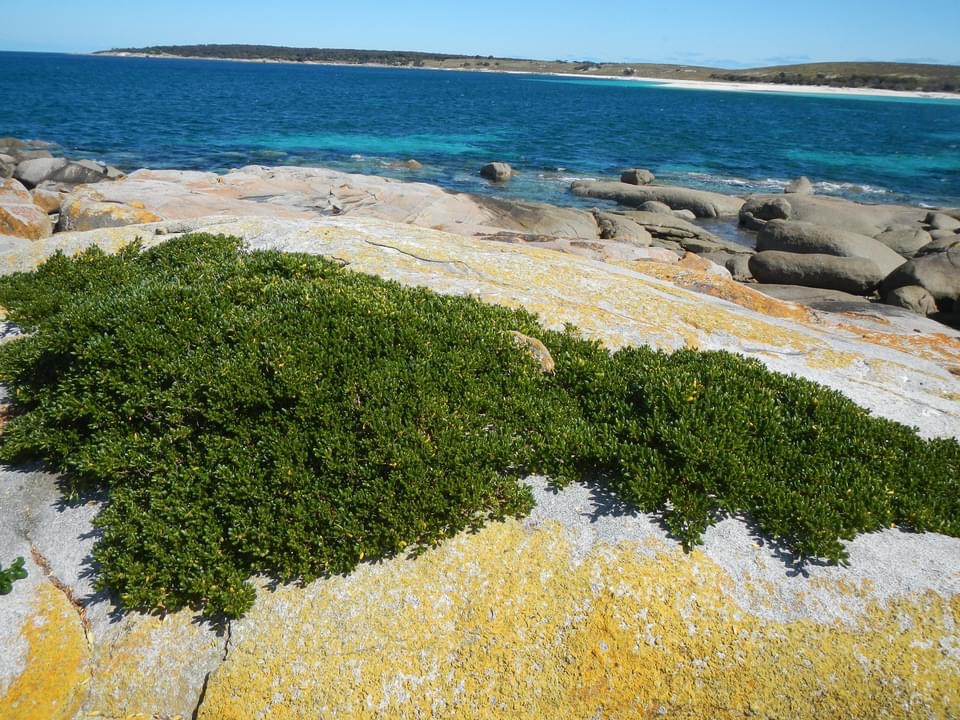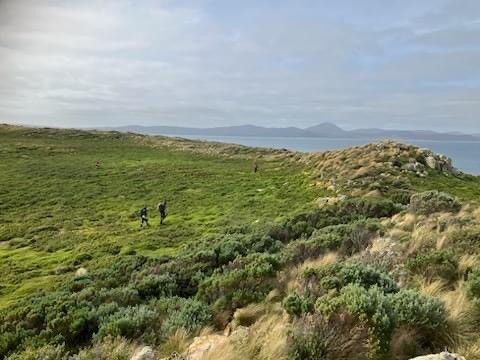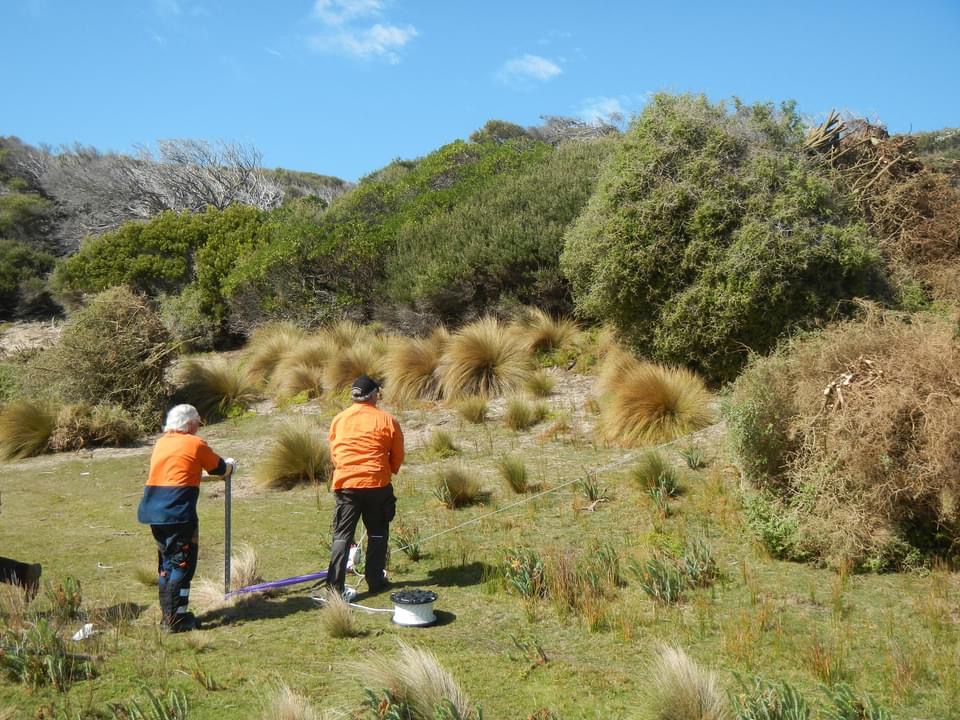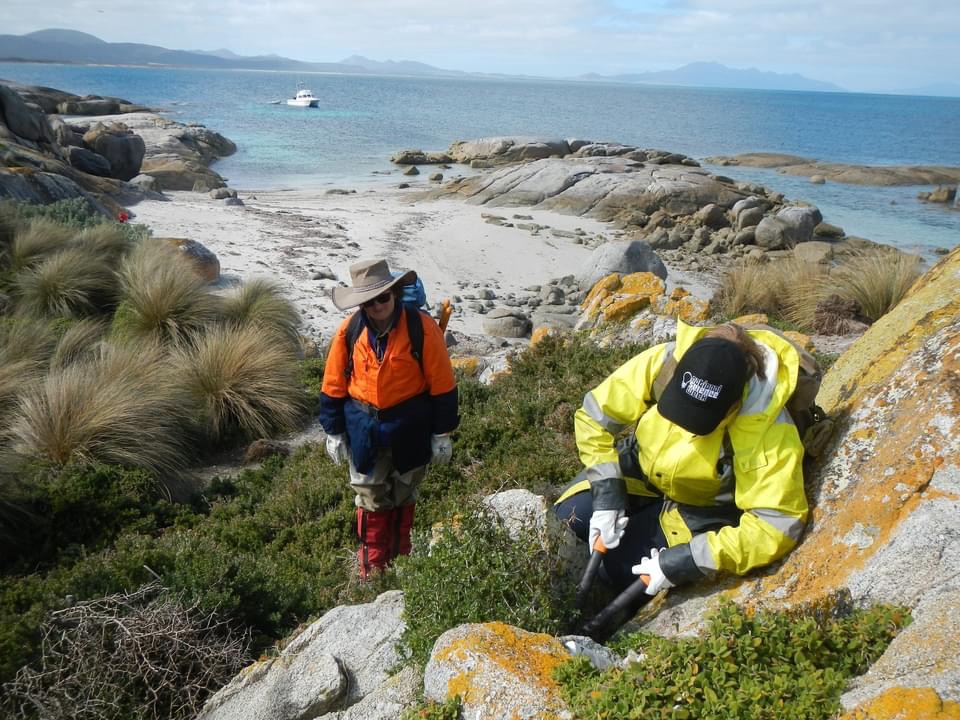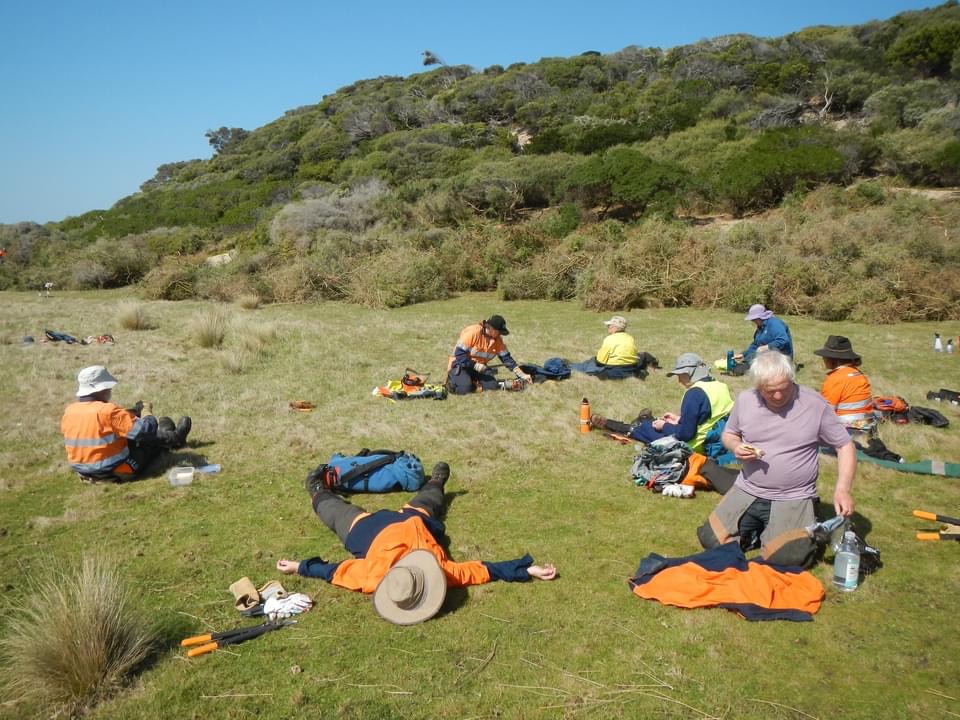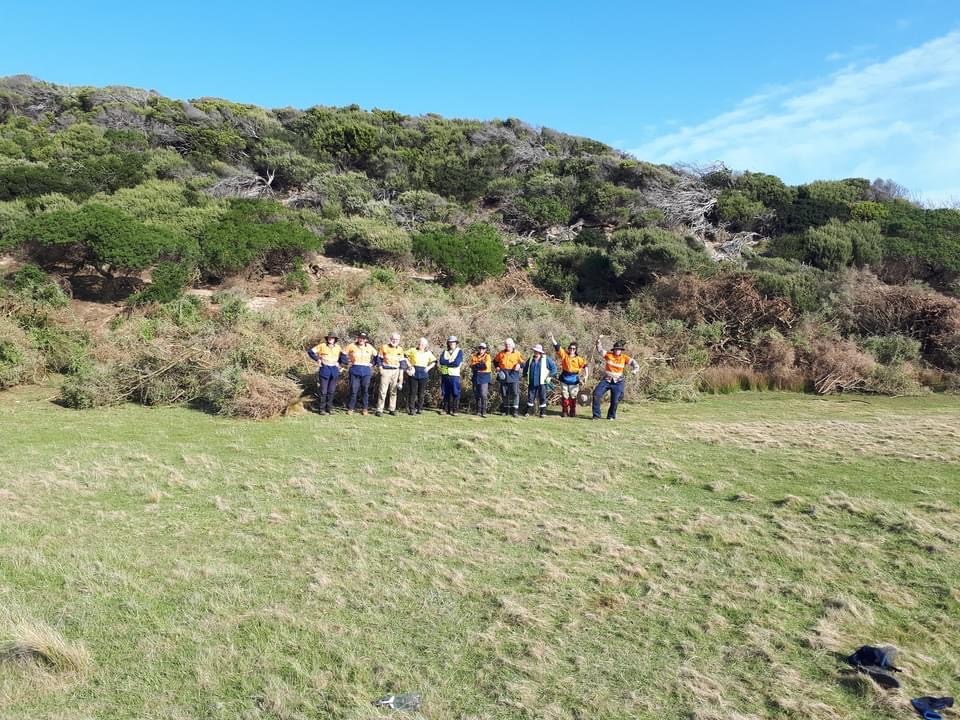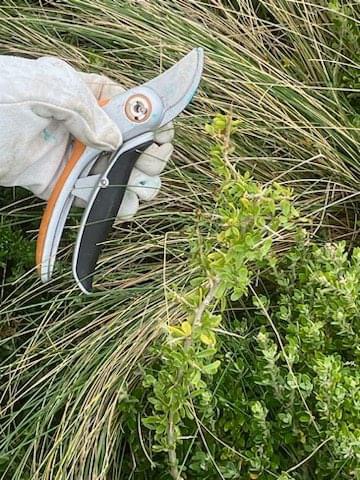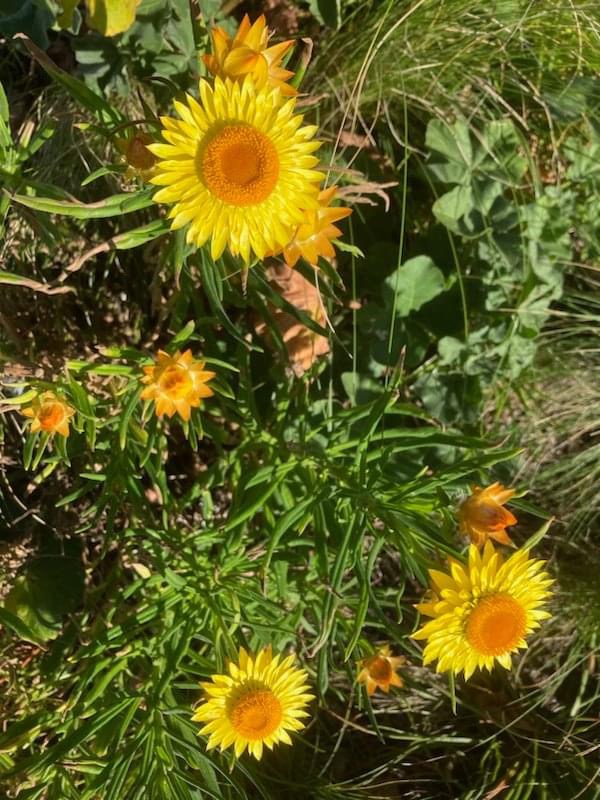Friends of Bass Strait Islands – Restoring seabird habitat by removing woody weeds
FRIENDS OF BASS STRAIT ISLANDS
the 2023 season
Restoring seabird habitat on the Chalky Group, Wybalenna Group, Pascoe Group, Roydon Island, Cat and Storehouse Islands in the Furneaux Islands by removing African boxthorn and mirror bush and removing marine debris. And working with Biosecurity Tasmania and SIRG on Islands in Franklin Sound that have been prioritised for work, including weed control.
With the support of grants from Birdlife Australia Community Grant, the Tasmanian Nature Conservation Fund administered by Wildcare and the Weed Action Fund administered by NRM North, Friends of Bass Strait Islands have just completed work that forms a critical part of the long-term African boxthorn removal strategy that has been in operation since 2002. The project also aims to prevent the establishment of mirror bush on the islands regularly visited by FOBSI in the Furneaux Group in Bass Strait.
FOBSI President, Karen Ziegler, reports on the project:
The principal focus of the recent work has been follow-up to control regeneration of boxthorn and to prevent the establishment of mirror bush which we are increasingly finding on the islands. Follow-up and prevention are relatively easy and cheap, in comparison to the formidable task of primary control of established weed infestations as we have achieved on Roydon Island.
The major objective has been to remove woody weeds including boxthorn and increasingly mirror bush from these locations, to permit the re-establishment of native vegetation from the soil seed bank. This has proven very effective. These follow-up trips aim to stay on top of any regeneration of boxthorn and introduction of mirror bush in bird faeces prior to the woody weeds reaching maturity and producing seed. Where we are finding mirror bush, we are increasing the frequency of follow up before mirror bush could otherwise reach maturity and start to seed on the islands, as seen on Wybalenna Island in 2021.
- The priority is to prevent the mirror bush becoming established. We are doing this first, before the boxthorn.
- The Southern end of Chalky Island. The follow up is under control.
Method
The focus of this year’s program was the follow up boxthorn and mirror bush control on Chalky Island Group, Wybalenna Island Group, the Pascoe Group, Cat and Storehouse islands in the Babel Group. Some work also occurred on coastal areas of Flinders Island that are strategic in protecting the outer islands and in protecting natural areas on Flinders Island. Some work also occurred on the foreshore of Whitemark to increase the community awareness of the problems of woody weeds and to the possibility of controlling them.
It is very important to control a rapidly establishing population of mirror bush on Wybalenna Island as it could easily engulf the island and be moved by birds to other islands. Islands must be monitored for regeneration to ensure regrowth and seedlings are removed. Boxthorn regeneration has proven to be irregular and possibly tied to particular weather conditions as regeneration does not occur every year. There is evidence that soil stored seed remains viable to germinate many years after the initial control of plants. Regeneration of the mirror bush is primarily around the initial plants discovered but is possible almost anywhere, including in cracks in rocks, amongst tussock, under other shrubs. They are “great” weeds!
Follow up treatment of boxthorn used throughout FOBSI’s work in the Furneaux Group involves either hand pulling seedlings or the ‘cut and paint method’, using secateurs and loppers for small plants, followed by the immediate application of Vigilant 11. We have moved to using Vigilant Herbicide in situations where we may encounter mirror bush and are only dealing with small boxthorn as it is effective on both species, and is less messy than a liquid in a small spray bottle.
Marine debris that we could carry was bagged and removed and disposed of at the Whitemark tip. Interesting bits and pieces have also be up cycled by Esther Nunn who lives on Flinders with her family.
- Innovation in the way of a winch to roll the big ones with one of the Flinders PWS staff. Emita Coastal Reserve.
- Wybalenna Island
Results
With the funds from the various grants, we were able to charter “Strait Lady” for access islands to undertake the monitoring and removal of woody weeds.
The primary weed on Wybalenna Islands is mirror bush, while in the Chalky, Pascoes, Roydon, Cat and Storehouse the primary weed is still boxthorn with only occasional mirror bush being encountered. Many FOSBI volunteers also worked on the Biosecurity Tasmania project on Briggs Islet, Little Dog Island and Fisher Island.
The result of the project has been the removal of woody weed predominantly in an immature stage which is resulting in diminishing numbers of boxthorn being found through the monitored islands.
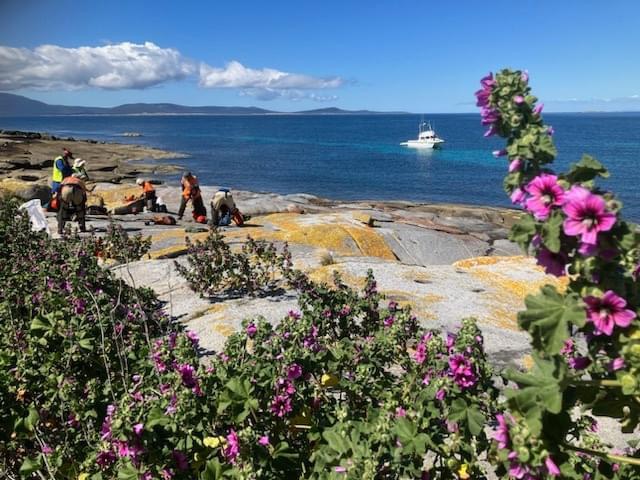
First time to Little Badger Island. Got the mirror bush and started on the boxthorn. Probably another 2 days required next year.
Wybalenna Island had an explosion of mirror bush in 2021 including seeding plants. After annual visits in 2021, 2022 and again in 2023 this is now back to being able to undertake follow -up in a day – this includes the small satellite islets to the south. And while some plants have started to flower, none had fruit.
In summary we are able to maintain habitat for nesting seabirds on the islands which include recorded habitat for short-tailed shearwater, white-face storm petrel, Pacific gull, little penguin, sooty oyster catchers, black faced cormorants, fairy tern, and silver gull. This year has also seen a high number of Cape Barren goslings.
Marine debris removal has been predominantly plastic bottles, buoys and rope. Large articles including freezers and truck tyres have been left. The removal of marine debris will reduce local microplastics but it is impossible to define the degree to which this facilitated by our collections.
We achieved good cover with 10 to 12 volunteers on the days we worked on. We had 9 volunteers from the Tasmanian mainland and up to 3 local volunteers from Flinders Island. The regeneration that we encountered and treated was predominantly immature and not yet carrying seed.
The removal of marine debris is having a sound value adding to our primary aim of habitat protection /restoration. The major cost is charter and we can remove smaller items easily.
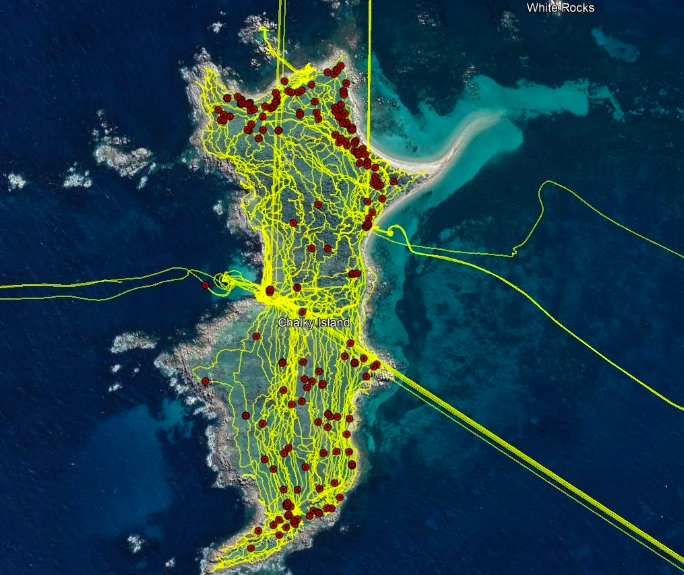
This is the mapping from Chalky in 2023 which shows the basic data we are collecting on follow-up trips. We collect tracks to give an idea on coverage and areas that we don’t find plants. It gives us a quick summary of areas that we may have to focus on the next year if coverage has been less, especially if in the past these areas have had infestations of either weed. We are differentiating between mirror bush and boxthorn, however only boxthorn has been recorded on Chalky Island. We are placing a priority of revisiting sites with mirror bush as regrowth and regeneration is more frequent for this species.
While the number of points with regenerating weeds is relatively high, these plants are very small in general and being removed before they can seed. These plants have little impact on habitat quality.
The pattern of distribution still largely reflects the original distribution of boxthorn on the island back in 2002. This suggests that it is still soil stored seed that is germinating, and this is slowly diminishing. New locations away from previous infestations tend to be focused on perching rocks both on the coast and inland on the islands.
Lessons learned
We will need to target Little Chalky follow up earlier in the year because sea eagles are nesting there, on the slight raised rocky area to the west. The nesting birds were observed prior to leaving the charter boat and we immediately left the area to work on other islands. Little Chalky will go onto next year’s schedule for the period before July.
We are very fortunate this year to have a new Ranger in Charge that is very enthusiastic having volunteers assist with management of reserved lands in the Furneaux Region. This has led to very positive experience for volunteers and greater on ground outcomes. It has made lining up contingency areas to work on much more strategic for broader conservation outcomes. It has also resulted in exchange of innovations. It has meant that we have really felt part of a team.
Physiologically, this has been great rather than at times feeling that it has been a battle to get permission to work on reserved land. Sadly, the new ranger is only likely to have a 3-year posting. We can only hope that it is extended.
- Flat out!
- FOBSI Friends
Next Steps
A program of follow-up on the islands will continue with the aim of annual follow-up where mirror bush has been encountered. Mirror bush is proving a very aggressive invasive species in Bass Strait. It is strongly competitive and will establish through dense native vegetation. It grows in cracks in rock. It layers readily. It reaches maturity very young, procuring seed in its second year. It will grow in the sea spray zone and further inland.
When we have capacity we will target additional seabird breeding islands for management of woody weeds, prioritising those where mirror bush and boxthorn is not yet firmly established. The selection of other islands will be in consultation with the Land Manager and Biosecurity Tasmania and the SIRG.
- Training ourselves to spot the little ones
- The warmer Spring has given us the treat of many herbs flowering on the islands.
